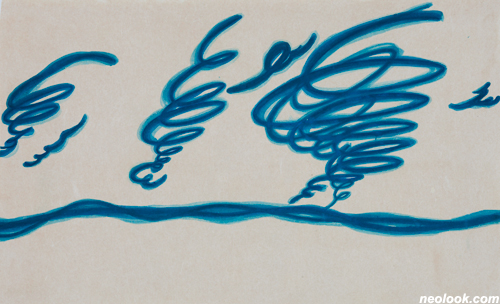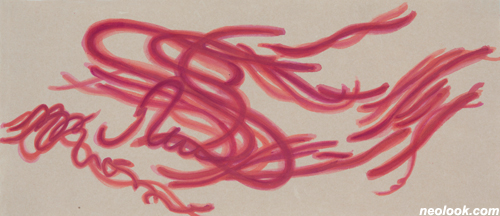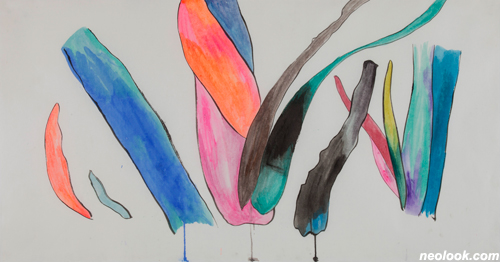- ● homepage
- ● archives
- ● restoration
- ● books
- ● big banners
- ● post board
- ■ neo's search
- ■ about us
- ■ 게재방법 안내
- 개인정보처리방침

- [email protected]
- Tel. 02_335_7922
- Fax. 02_335_7929
- 10:00am~04:30pm
- 월요일~금요일
- 3/3(월) 대체공휴일

리듬의 풍경 _내가 있는 곳
구세진展 / KOOSEJIN / 具世珍 / painting 2015_0708 ▶ 2015_0714

- 구세진_바람 부는 곳_종이에 채색_31.5×52cm_2015
별도의 초대일시가 없습니다.
관람시간 / 월요일_12:00pm~06:00pm / 화~일요일_11:00am~06:00pm
갤러리 도스 GALLERY DOS 서울 종로구 삼청로 7길 37(팔판동 115-52번지) Tel. +82.2.737.4678 www.gallerydos.com
에너지의 리듬 ● 예술에 있어서 표현이란 내면 안에서 이루어지는 깊은 사색과도 같다. 그렇기에 예술이라는 창작활동은 자신 안에 갖추어져 있는 잠재적인 힘을 끌어내어 발달시켜 가는 과정이라고도 할 수 있다. 구세진은 요가라는 심신의 수련으로 얻은 기(氣)의 체험을 통해 자연과 소통하고 이를 예술로 표현하고자 한다. 의식의 힘에 억눌려 있던 창조적인 에너지는 호흡을 통한 내적 수행에 의해 발동하기 시작한다. 그로 인해 마음의 찌꺼기 즉, 잡념과 망상을 해소함으로써 눈에 보이지 않는 기(氣)의 흐름을 바라볼 수 있는 순수한 시각을 가지고 창작의 길로 향할 수 있게 된다. 화면에 표현된 유기적 형상들은 자연과 대화하고 눈에 보이기 않는 자연의 본질적 요소를 표현한 노력한 결과물로써 자연을 변형하고 추상화한 것이다. 작가는 기(氣)를 통한 감각적 표현을 통해 새로운 조형언어를 만들어내고 그 속에 내재해 있는 생명력을 표현하고자 하는데 창작의 의미를 두고 있다.

- 구세진_구름_종이에 채색_23×53cm_2015
구세진은 모든 에너지의 근원은 자연임을 전제로 작업에 임한다. 작가는 평범한 생활 속 체험을 통해 내 안에 내재된 자연의 본질을 자각하고 그곳에서 창작의 원동력을 얻게 된다. 요가라는 심신의 단련을 통해 평온한 마음으로 나 스스로를 발견하고 자연에 대한 소통의 발현이 표현의 행위로 이어지도록 노력한다. 화면 안에서 '그린 것'과 '그리지 않은 것', '비어 있는 것'과 '차있는 것'의 상호작용을 통해 무의식 안에 잠재된 동양에서는 기(氣)라고 불리는 자연의 에너지를 표현한다. 이처럼 동양적 사고의 일환으로 겉으로 드러난 유형이 아니라 에너지로 느껴지는 무형의 이미지를 그려내고 있다. 마음의 눈으로 자연 속에 내재된 에너지의 울림을 바라보고 상상력을 발휘해 한 결과로 작가는 자연이 가진 유기적인 형태를 현실의 시공간을 뛰어넘어 자유분방하게 화면 위에 펼쳐놓는다. 유기적이라는 것은 생성, 소멸, 순환하며 스스로 끊임없는 변화를 거치는 생명현상의 근원을 말한다. 작가는 만물이 어떻게 형성되는지를 자연을 관찰하고 상상하면서 그 외형의 껍질을 조심스럽게 벗겨낸다. ● 움직임에는 에너지가 내재되어 있기 때문에 작가에게 있어 리듬은 가장 핵심이 되는 조형요소이다. 작가에게 리듬은 생명을 불어넣어주는 호흡이며 세상을 열린 마음으로 유연하게 바라보는 방식이다. 그 자체가 바로 예술의 생명이며 자연의 에너지를 가장 효과적으로 표현하는 본질적인 요소인 것이다. 리듬의 사전적 의미는 '흐르다'라는 뜻의 그리스어 'Rhythmon'에서 유래한 말이다. 이처럼 리듬은 작품 안에서 대상을 바라보는 고정된 시각에서 벗어나게 해주고 자유자재로 이동하는 에너지의 흐름을 추상화하고 있다. 리듬은 서로 다른 요소들로 된 구조 안에서 그 요소들이 강약이 되어 규칙적으로 나타나는 현상을 의미하는데 주로 반복된 선적인 요소를 통해 드러난다. 화면 안에서 선은 연속성, 방향성과 운동성을 가지고 있기에 에너지의 리듬을 생동감 있게 전개시키는 데 효과적이다. 힘의 조절과 연결이라는 행위로 이루어진 선들이 보여주는 반복과 중첩의 리드미컬한 화면은 자연이 가진 생명력을 지향한다. 이처럼 작품에 있어서 중요한 부분을 차지하고 있는 선을 긋는 행위 안에는 작가의 내재적 기운이 담겨있으며 기(氣)를 이용한 선의 표출은 추상성을 동반하고 의식과 이성을 완전히 해방시켜 자연의 본질로 좀 더 쉽게 다가서게 한다. 또한 인간 내면에 잠재되어 있는 표현 본능에 가장 근접해 있는 행위이기에 이는 어쩌면 인간 최초의 표현 행위일지도 모른다. 기하학적인 무늬들은 원시적인 에너지를 품은 듯 보이며 작가는 그 안에서 리듬을 느끼고 자연을 느낀다.

- 구세진_꽃과 풀_종이에 채색_73.5×140cm_2015

- 구세진_꽃과 풀_종이에 채색_73.5×140cm_2015
구세진의 작품에 있어서 또 하나의 특이점은 오히려 자연물에서는 찾아보기 힘든 과장되고 인공적인 원색을 사용한다는 점이다. 자연에서 오는 신비로움과 경이로움을 약간은 불협화음이 느껴지는 화려한 색채들로 포장하여 현실을 초월한 환상적인 측면을 극대화시키고 있다. 이는 보는 이의 마음을 자연이라는 본질의 세계로 초대하고 시공간을 넘어 현실을 잠시나마 잊게 해주는 치유의 역할을 수행한다. 서로 섞이고 흘러내리며 어우러지는 기(氣)의 향연 안에서는 역동성마저 느껴진다. 우연히 만들어지는 물감의 얼룩들과 선이나 붓 터치가 주는 반복의 과정은 자연스럽게 내면으로 통하는 무의식과도 연결된다. 반복한다는 것은 눈에 보이지 않는 본질과 관계하면서 행동하는 것으로 해석될 수 있으며 이는 화면과 작가가 끝없는 대화를 주고받고 있음을 반증하는 결과이다. 작업과정에서 드러나는 색의 표면은 에너지를 발산하는 것처럼 보이며 그 안에는 작가가 가진 세상에 대한 호기심이 전제되어 있다. ● 구세진에게 예술은 내면의 정신세계를 들여다보고 신체행위를 빌어 자연의 생명력과 접근하는 방식이다. 즉, 자연은 자신을 담는 사유의 장(場)과도 같다. 작가는 자아에 열중하며 느림과 빠름, 가벼운 것과 무거운 것, 소리와 침묵, 보이는 것과 가려진 것 간의 리듬을 통해 자연의 에너지를 이끌어낸다. 또한 요가 수행을 통한 자연과의 직접적 교감과 더불어 순수한 예술의 창작행위를 통해 표현의 자유로움을 유도한다. 자연을 통해 체득한 감각은 선이 가진 속도와 색이 가진 긴장을 통해 시각적인 리듬을 갖게 되고 이는 자연스럽게 우주의 기(氣)로 표출되는 것이다. 이번 전시를 통해 작가는 자연의 순리를 깨닫고 소통하며 궁극적으로 본인을 재발견하려는 의지의 단면을 보여주고 있다. 그리고 궁극적으로는 보이는 세계와 보이지 않는 세계의 소통을 지향하고자하는 회화적 실험의 일환이라고 보아도 무방하다. ■ 김미향

- 구세진_풀_종이에 채색_73.5×140cm_2015

- 구세진_풀_종이에 채색_73.5×140cm_2015
The Rhythm of Energy ● When it comes to art, expression is profound contemplation inside oneself. It is the reason why the creation of art can be referred to as a process of deriving and developing one's own potential. Sejin Koo wants to communicate with nature via experience of "Qi" attained by practicing yoga, disciplining the mind and body, and intends to express it. Internal practice through breathing activates creative energy that had been oppressed by consciousness. By getting rid of all the debris of mind, that is, worldly thoughts and delusions, one can embark on the journey of creation, with an innocent point of view. Koo's attempts to interact with nature and capture its essential elements resulted in organic forms from her works which are a transformation and abstraction of nature. Therefore, she aims to invent new visual languages and express vitality within them. ● Koo's works are based on the notion that the origin of all the energy lies in nature. She became aware of the essence of nature from ordinary experiences, which inspired her to create. She also found herself doing yoga, training herself both physically and mentally, and tried to connect communication with nature to painting. Natural energy, or Qi embedded in her subconsciousness was described in her painting by interaction of "what is drawn" with "what isn't drawn" and "emptiness" with "fullness." As part of oriental thinking, she portrayed not visible forms but informal images that embodied energy. Looking at echoes of energy through her mental eye, she freewheelingly unfolded natural organic forms on her works beyond space-time. Being organic means quiddity of vital phenomena that constantly change through the cycle of birth, death, and rebirth. Observing and envisioning how all nature is formed, Koo discreetly removed the external. ● Rhythm is the most central visual language because of inherent energy in movements. To her, rhythm is tantamount to breathing which infuses life, and a way of flexibly seeing the world with an open mind. Rhythm itself is the heart of her art and a fundamental element that depicts natural energy most efficiently. In the mean time, the word "rhythm" is originated from the Greek word "Rhythmon", of which the dictionary meaning is "to flow." Rhythm sets the audience free from a fixed viewpoint and abstracts the flow of energy that moves freely. Rhythm, a regular dynamics of different elements, mostly appears from repeated linear elements. Because lines in a painting have continuity, directivity, and mobility, they are efficient in vigorously developing rhythm of energy. Repetition and overlap of lines made up of dynamics of forces made her works cadenced and were oriented to natural vitality. As such, drawing lines, a crucial part of her works, incorporated her intrinsic vigor. And lines that are drawn with Qi entailed abstractness, completely liberated consciousness and rationality, and allowed the audiences to approach the essence of nature. Drawing also might be the initial expression of a human being since it is the most proximate action to human instinct. Geometrical patterns seem to bear primitive energy, through which she senses rhythm and nature. ● Using exaggerated, artificial and bright colors which are barely found in nature is another idiosyncrasy Koo has. Decorating nature's wonder with slightly discordant colors, Koo maximized the fantasy far beyond reality. These works of art invited the audience to the essential world called nature, and healed them by letting them forget their reality. Combining and flowing, harmonious feast of Qi made the audiences feel full of life. Besides, color strains made by chance and repeated lines and brush strokes led to subconsciousness, subsequently, to the inner side. Repetition can be interpreted as interaction with invisible essentials, which proves that Koo have ceaselessly talked to the images she worked on. Colors she used appear to give off a great deal of energy, and they reflect her curiosity about the world. ● To her, art is a way to gaze at human psyche and access to natural vitality through physical activities. Thus, nature is equivalent to a forum for reflection that defines oneself. Concentrating her own ego, she induced natural energy via rhythm between the slow and the fast, the light and the heavy, sound and silence, the visible and the invisible. In addition, she induced unconstrained expression not only by direct communion with nature through yoga practices but also by creation of fine art. With the velocity of lines and tension of colors, senses acquired in nature got to possess visual rhythm, which naturally emerged as Qi of the universe. In this solo exhibition, Koo showed her intention to grasp the laws of nature, communicate with nature, and ultimately rediscover herself. This exhibition, eventually, is a kind of pictorial experiment that pursues communication between the visible and the invisible. ■ Mihyang Kim * Translation_Soohyun Woo
Vol.20150707g | 구세진展 / KOOSEJIN / 具世珍 / painting
